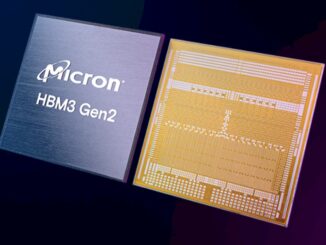
Over the last twenty years, memory has risen from ten percent of the semiconductor market to almost 30 percent — a trend that is expected to continue, propelled by compute at the edge all the way up to datacenter. To meet these demands, memory giant Micron has announced it will make $150 billion in internal investments, ranging from manufacturing and fab facilities to R&D to support new materials and memory technologies.
The nature of the announcement serves two purposes. The first is obvious: Micron is putting a stake in the ground around its bullish view for edge to datacenter growth and its role as a primary component maker. The second is only slightly less obvious: to compel the U.S. government to match funds or continue new investment strategies to support U.S. fabs and semiconductor R&D.
While $150 billion is a sizable investment, the fab component of Micron’s plans will gobble up a significant fraction. While no fab is created equally, consider TSMC’s investments in new facilities, which are upwards of $9 billion. Such investments can take two to three years to yield but the time is certainly right. Gartner, for instance, estimates the costs for leading-edge semiconductor facilities to increase between 7–10 percent.
While DRAM and NAND are less expensive than leading-edge technologies, Micron will need to choose carefully as it sets its plans in motion. Luckily, there is ample government support building in the U.S. for all homegrown semiconductor industry, although it is unclear how federal investments — including the $52 billion CHIPS Act — will augment Micron’s own ambitions.
Micron is seeking the attention of government with its broad R&D and manufacturing investment, pointing to the creation of “tens of thousands” of new jobs and “significant economic growth.” In a statement, Micron explained that memory manufacturing costs are 35–45 percent higher than in lower-end semiconductor markets, “making funding to support new semiconductor manufacturing capacity and a refundable investment tax credit critical to potential expansion of U.S. manufacturing as part of Micron’s targeted investment.”
“The growth of the data economy is driving increased customer demand for memory and storage,” said Executive Vice President of Global Operations Manish Bhatia. “Leading-edge memory manufacturing at scale requires production of advanced semiconductor technology that is pushing the laws of physics, and our markets demand cost-competitive operations. Sustained government support is essential for Micron to ensure a resilient supply chain and reinforce technology leadership for the long term.”
Micron CEO Sanjay Mehrotra says the company will “look forward to working with governments around the world, including in the U.S., where CHIPS funding and the FABS Act would open the door to new industry investments, as we consider sites to support future expansion.” The subtext there is that the U.S. is only one country in the running, among others making investments.
Increasing government support will likely align with fabs and facilities but Micron says it’s working on next-generation technologies set to keep pace with growing demand.
This is part of the company’s 2030-era plan for memory technology. Micron sees edge and cloud deployments expanding but also points to AI as the leading workload across deployment types. The company’s senior VP and GM for Compute and Networking, former Intel HPC lead, Raj Hazra, says that by 2025, 75 percent of all organizations will have moved beyond the AI experimentation stage into production.
To support this more practically, Micron has set forth some ambitious near-term targets, including reaching for 40 percent improvements in memory densities over existing DRAM, double SSD read throughput speeds over current 1TB SSDs, 15 percent power reductions over existing DRAM and 15 percent better performance for mixed workloads over existing NAND.





Be the first to comment